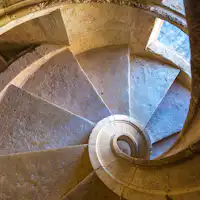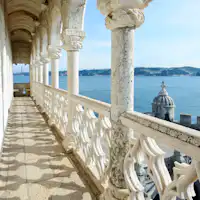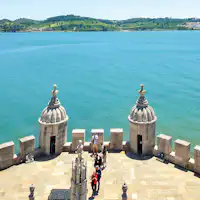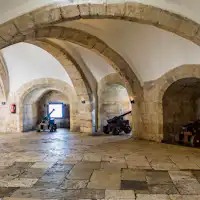Lisbon's Belém Tower has closed for conservation and restoration work as part of the Recovery and Resilience Plan
The Belém Tower, located in the beloved city of Lisbon, is a symbol of Portugal’s age of discovery. The tower was built on the northern bank of the Tagus River for the city's protection. It remains a powerful reminder of the seafaring nation’s glorious past. From its impressive silhouette against the riverfront backdrop to the stories behind its construction, this architectural masterpiece has remained one of Portugal’s defining symbols for centuries.
The tower was later converted into a lighthouse and customs house. Today, the Belém tower is a popular tourist attraction in Portugal. UNESCO declared it a World Heritage Site, adding it to its lists and protecting it at the end of the 1980s. Discover whether the Belém Tower Ticket is worth your money by reading on.
Essential Information for Visiting Belém Tower
Things to know
Number of visitors per year: 500,000
Established: 1514
Architect: Francisco de Arruda
Architectural style: Gothic Architecture
Opening Hours And Address
10:00 AM to 5:30 PM (October-April). Last entry: 5:00 PM
10:00 AM to 6:30 PM (May-September). Last entry: 6:00 PM
Closed on: Mondays, Jan 1st, May 1st, Christmas Day and Easter Sunday.
Address : Av. Brasília, 1400-038 Lisboa, Portugal
Get Directions

Why must you visit the Belém Tower?
Well, for starters, just look at it! This incredible six-story tower is an architectural work of art. Its intricate design makes for a stunning photo op and will certainly add to your Instagram feed. But beyond its beauty lies a long history of power and protection—the tower was once used to protect the city from naval attack. Today, you can explore its many levels and learn about its past as part of Portugal’s rich cultural heritage. And while you’re at it, you must make sure to explore the Jeronimos Monastery as well.
These two iconic landmarks stood as reminders of Portugal's nautical achievements and were built during the Golden Age of Discovery.
Recommended Belém Tower Tickets
According to a survey, more than 500,000 people visit the Belém Tower every year, making it the most popular tourist destination. Purchase a ticket to Belém Tower and feel free to enter during any time of the day. You can also purchase a Belém Essential Combo: Belém Tower + Jerónimos Monastery Tickets ticket to visit Lisbon’s historical attractions at a combo offer.
Belém Tower History

Originally built to protect Lisbon from incoming raids along the Tagus River, the Belém Tower (Torre de Belém) was built in the 16th century around 1515 by Francisco de Arruda. It was also the beginning of the ship's voyages. The Tower was built due to the desire of King Manuel I's predecessor, King John II. Later on, it served as a lighthouse and prison for politicians. Jerónimos Monastery and the Belem Tower have been UNESCO World Heritage Sites since 1983.
Given its landmark status, it has often been recognized as Europe's Age of Discovery and as a symbol of Portugal or Lisbon. Due to the Lisbon earthquake of 1755, the Tagus was redirected and now sits near the shore rather than in the middle of the river. This Tower is also referred to as the Tower of Saint Vincent. It has been named in honor of Lisbon's patron saint and commemorates Vasco da Gama's expedition to India in 1497-98. Most of the vessels arrived and departed from Belém's beach (Praia do Restelo), which protected them from the strong winds originating from the Atlantic Ocean. The Belém Tower was commissioned in the late 15th century as part of a larger defensive complex for Lisbon's port, which included the Fort of So Sebastio da Caparica and the Tower of Santo António at Cascais.
Belém Tower's Unique Architecture

There is little doubt that the Tower of Belém is a superb example of the Manueline style of architecture. It was a common and most prevalent style in 16th-century Portugal. The Manueline style encompassed aspects of Gothic and Italian Renaissance architecture. It was in the 16th century, during the Portuguese Renaissance and the Age of Discoveries, that the Manueline architecture style, sometimes called Portuguese late Gothic, was developed. There are, however, architectural details that suggest the Gothic style popular in Portugal in the 1400s, such as ribbed vaults, tall columns, gargoyles, and tracery above balcony parapets. The style of the Torre de Belém is a blend of medieval (a tower) and Renaissance (a bastion) elements, similar to the structure itself. The presence of maritime motifs is another important characteristic of the style. In particular, twisted ropes adorning the Tower's riverfront southern façade and embodying the building's connection with navigation. When placed around the monarch's coat of arms, these symbols symbolize the monarch's role as a driving force for Portuguese nationalism. Symbolically, the crosses found throughout the building symbolize the connection between seafaring and exploration. A rhinoceros carving found in one of the watchtowers underscores Portugal's international connections, even as the motifs associated with the Manueline style signal the expansion of Portuguese territorial power.
Inside Belém Tower

The Spiral Staircase
The tower has five levels connected by a spiral staircase. Once the visitors enter the small door, they can take the staircase upwards. These stairs are so narrow that they’ve installed a traffic signal setup to go up and down the stairs.

Lower Battery
Regardless of where you stand in the tower, make a point of heading down to the Lower Battery to take in the panoramic views: You can observe any boats approaching from the Atlantic. Once you're done admiring the view from the Lower Battery, move up the narrow spiral staircase and climb to the First Floor.

The Governor's Chamber
The Governor's Chamber is accessible by a narrow flight of stairs and is octagonal in shape. In the 16th century, this room housed the position of Governor of Belém Tower - always a highly prestigious role among royals.

The King's Chamber
The King's room has a balcony that overlooks the southern side of the tower. There are eight round holes in the Floor of the King’sroom, called machicolations, through which the garrison could shoot or drop projectiles to fend off attacks. There are also three holes in each corner of this room for serving food or drink.

Chapel - Fourth Floor
A second panoramic terrace, typical of Manueline style, is found on the 4th Floor and formed part of the G. Chapel, a chapel that became a parish after becoming popular and was eventually incorporated into the Hieronymite monastery.

The Terrace
The terrace offers stunning views of the Tagus Estuary and riverbanks from the top of the tower, as are those of Belém and its monuments. Looking northward from the terrace, one can see the secluded Chapel of St. Jerome (Capela de So Jerome) among the trees on Avenida da Liberdade.

Upper Battery
The Upper Battery was built on the second floor in 1519 to protect the entrance to Lisbon’s harbor from foreign invaders. Lined with cannons and manned by soldiers, it served as a powerful fortification against outside forces.
Best time to visit Belém Tower
Belém Tower is best seen either early morning to participate in a tour at 10 am or in the evening to watch a beautiful sunset at Targus River. Tourists are least likely to visit Belém in October, as April is the busiest month for tourism. Hotel and flight prices will be the highest during these months, but you can save if you book well in advance. This is likely the least expensive month for those willing to visit during these times.
There is no access to the tower on Mondays, New Year's Day, Easter Sunday, May Day (1 May), and Christmas Day. Photos of the tower's striking exterior are still available when the tower is closed on those days, but you won't be able to climb inside. Take the best photos around the tower on the right, away from the busy pedestrian area and the line. When the tower is framed against an orange sky and the river at sunset, it is a particularly good time to photograph it.
Belém Tower Opening Hours
- 10:00 am to 6:30 pm from May to September. Last admission is at 6:00 PM
- 10:00 am to 5:30 pm from October to April. Last admission is at 5:00 PM
- The Belém Tower is closed on Mondays and on the following days: 25th December and 1st January, 1st May and 13th June.
How to get to Belém Tower from Lisbon
Despite being the most famous monument in Lisbon, Belém Tower is actually located far away from the city center, about 6 to 9 kilometers from the center. It is located on the Belém coast. There are several modes of transportation you can choose from, including tram, train and bicycle. You may have to buy tickets for more than one transportation based on your location.
Bicycle
Heading to Belém on a bicycle is one of the best ways to explore the city around you. The pollution is at a minimal, the roads are mostly flat or very slightly up/down hill, and the journey lasts onlt 35 minutes. The best part? You'll be cycling along the River Tagus, that'll present you with some of the most beautiful views!
Tram
Trams heading to Algés (Jardim) run regularly (every 10-15 minutes). The ride takes about 25 minutes from Praça da Figueira.
Train
Take the 19001 train from Lisbon to Belém Tower, its journey time is around 8 minutes, and it covers a distance of approximately 5 km.
Restaurants near Belém Tower

This futuristic area signifies 'East-West' and is located on the first level of the remarkable CCB cultural facility. As a result, it offers an intriguing mix of good, mid-priced wood-fired pizzas, and very fresh Japanese sushi. The primary lure, though, is its magnificent roof terrace, which offers commanding views of Belém's landmarks and riverbank and a beautiful roof garden dotted with olive trees.

The long-established restaurant has a stunning view of Belém's marina, home to some of the most famous yachts in the world. It has a variety of upmarket seafood options and grilled meats, as well as a nice wine list.

As its name suggests, 'Manor of the Ambassador' is a small family restaurant offering excellent Portuguese and Brazilian cuisine at a good price. Fish like mackerel, prawns that have been grilled, and octopus await you here. You'll also find a TV in a corner if you're into sports.
Belém Tower facts that you probably didn’t know
- Heritage: 1514-1520 was the period during which this tower was built. It has witnessed the best and worst aspects of Portuguese heritage, having lived during some of Europe's most turbulent periods.
- Ship Replacement: During King John II's reign, a permanent ship was stationed in the bay of Belém in order to protect the shoreline of the city from impending threats and/or attacks. This ship served as a deterrent over the shoreline during his reign but was removed by his successor.
- UNESCO: In 1983, the Belém Tower was added to the list of UNESCO World Heritage Sites when it proved to be one of the country's most important landmarks for a long time.
- Location Shift: The tower no longer has its own island after the great earthquake of 1755. The quake caused the river to shift and moved the small island closer to the land until eventually merging them. Belém Tower is today nothing more than a tower that stands on an island in the middle of the river, overlooking the water.
- Seven Wonders: Among the Seven Wonders of Portugal, the Belém Tower is one of the lesser-known wonders. Others include The Jerónimos Monastery (just across from the Belém Tower, and an absolutely stunning structure), Pena National Palace in Sintra, the Castle of Óbidos, Batalha Monastery, Alcobaça Monastery, and Guimarães Castle.
Belém Tower Insider Tips
- For those with limited mobility, there is medium accessibility
- Because this is a popular attraction, plan your visit accordingly, as there may be a line at the door
- The bottom level is accessible by wheelchair; however, some areas are cobblestoned
- There will be a 15-20 minute wait at the entrance/security
- Because there is no luggage room, leaving your bags at home is best
- Wear comfortable shoes, as you’ll have to walk up and down a narrow flight of stairs
Things to do around Belém Tower
FAQs
Its initial function was to safeguard Lisbon from impending attacks along the Tagus River. It also marked the start of the sailors' travels and their last glimpse of land.
Belém Tower and Jerónimos Monastery, both commemorating the Portuguese Age of Discovery, are two of the most prominent attractions in Lisbon. These two Lisbon landmarks form one of Portugal's World Heritage Sites and are definitely worth seeing.
Yes, you can. Given the size of the fort, approximately 150 people are permitted inside, which might result in long lines, especially during the high season.
Visitors should plan on spending at least one day in Belém to view the main sights. However, Belém is also known for its numerous museums, so spending at least two days here is suggested if you want to include them on your bucket list.
No dress code is applicable, however, it's suggested to wear comfortable clothes and shoes during your visit.







